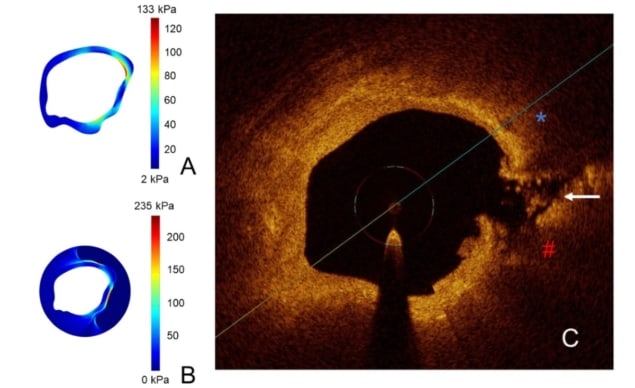
Understanding the forces behind blood clot formation could be the key to improving heart attack prevention methods, according to researchers from University Hospital of the RWTH Aachen in Germany.
Their proof-of-concept study, published in eLife, uses patient-specific computer models to examine the forces responsible for coronary plaque rupture. Plaques are fat deposits that can line the heart’s arteries; if a plaque breaks away from the artery wall, it can form a clot and subsequently cause a heart attack. Knowing when and where a plaque might rupture, based on the stresses exerted upon it, could allow physicians to provide life-saving preventive care.
“Including such analyses in clinical practice might allow cardiologists to predict a future myocardial infarction [heart attack] by looking – among other factors – at the stress distributions in diseased vessels,” says study author Mathias Burgmaier in a press statement.
Modelling plaque rupture
Coronary plaques consist of a layer of fibrous connective tissue (fibrous cap) covering a lipid-rich necrotic core. It is known that the cap fails when it is subjected to forces higher than its tensile strength. Nevertheless, the disruptive forces driving this biomechanical stress are not well understood.
“This may limit our ability to recognize and treat high-risk lipid deposits before they cause a myocardial infarction,” says co-first author Andrea Milzi. Cardiologists can use morphological characteristics such as fibrous cap thickness (FCT) to predict whether a plaque is vulnerable to rupture. FCT alone, however, does not provide an indication of where the rupture will likely occur.
In their study, the researchers combined high-resolution optical coherence tomography (OCT) imaging with finite element analysis to simulate how stress is distributed within the artery wall. They obtained OCT images from 20 patients with type 2 diabetes and coronary artery disease. “These analyses are particularly important in high-risk patients with type 2 diabetes,” explains Nikolaus Marx, head of Internal Medicine I, one of the largest cardiology departments in Europe.
All of the patients presented with coronary plaques. In each case, the researchers analysed the maximal stress in both the fibrous cap and the plaque as a whole. They discovered that the stress was up to fourfold higher in ruptured plaques compared with stable ones. What’s more, 50% of ruptures occurred in the immediate proximity of the highest cap and plaque stress. This spatial correlation between maximal stress and rupture not only suggests that high stress concentrations play a mechanistic role in plaque rupture, but that the stress pattern is influenced by plaque morphology. And it’s not just location: the model can also provide an estimate of the magnitude of force needed to promote cap failure.
“Our pilot study shows that OCT-based analysis of the forces within the vessel wall is a feasible tool to carry out patient-specific assessment of biomechanics in coronary lesions,” says Burgmaier.
The approach shows excellent potential for clinical application, scoring more highly on a diagnostic efficiency test than pure FCT analysis. Moving forward, the researchers aim to test their method on a larger number of patients and explore automation.



